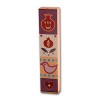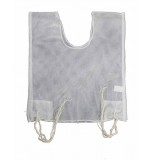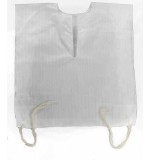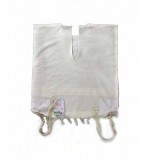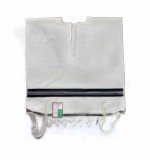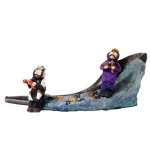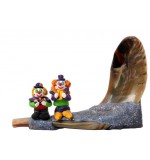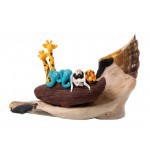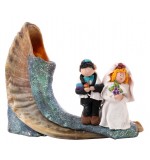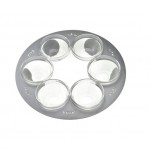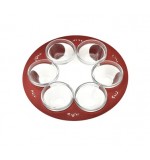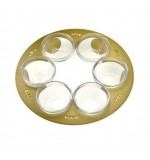Tzitzit
What is the reason for the Commandment of Tzitzit?
It is written in the Torah (Numbers 15:38) - "And they shall make for themselves Tzitzit on the corners of their garments". We are commanded to attach strings onto any garment which has four square corners.
The Importance of this Commandment
The source of this law is in the Torah portion Shelach -Lecha (Numbers 15:38-41) –“They shall make for themselves ‘Tzitzit’ (fringes) on the corners of their garments, for generations. And they shall put on the fringes a thread of Techelet, and it should constitute for you as Tzitzit. And you will see it and remember all of G-d’s laws and perform them."
Clearly, the special attribute of this law is that it reminds us of G-d’s commandments, and leads us to fulfil them.
Within the word ‘tzitzit’, lies a hint to the 613 commandments of the Torah:
The letters of the word – Tzitzit in Hebrew, have the numerical value of 600. Add to that the 8 strings, and the 5 knots - the total is 613, the exact amount of laws in the Torah.
By wearing a Tallit Katan, one is able to fulfil the Command of Tzitzit throughout the entire day.
How should this Commandment be fulfilled?
Nowadays, garments do not generally have four corners, thus the custom is to wear a particularly designated garment - a `Tallit Katan’, in order to fulfil the commandment. In addition, the custom is to wrap oneself in a special larger Tallit worn over the garment, during prayer.
When one dons the larger Tallit, one recites a blessing: "…Who sanctified us with His Laws and commanded us to wrap ourselves in Tzitzit". However this blessing is not recited upon wearing Tzitzit (the Tallit Katan), since this kind of wearing is not considered `wrapping oneself`. Instead one recites "… Who commanded us regarding the law of Tzitzit".
How to make Tzitzit
On our website, you can obtain a ready prepared Tallit and Tallit Katan, or you can buy the pieces separately and prepare it according to the instructions set forth below.
A package of Tzitzit strings come with 16 strings, four of which are longer than the rest. (The long ones are called ‘Shamash’). First, divide them into groups of four; with each group containing one longer string – a Shamash.
On each of the four corners of the garment there is a hole; thread the four strings through this hole, so that they double over in the middle and it seems as though there are eight strings in each corner. One of the eight strings will appear longer than the rest.
The threading, and subsequent knotting and winding, must be done with the intention that this is "for the sake of the commandment of Tzitzit". So here, before threading the strings of the Tzitzit through the garment, one should enunciate the words "for the sake of the commandment of Tzitzit".
The number of times that the strings of the Tzitzit are twined depends on various customs. We will describe the two main customs (see the diagram below):
After threading the strings through the garment, take the four strings from each side of the hole, and tie them together into a double knot. Then wind the longest string (Shamash) seven times around the seven remaining strings, and tie a double knot with all eight strings. Then wind the Shamash eight times around the seven remaining strings.
Tie another double knot, and then wind the Shamash eleven times around the seven remaining strings. Tie another double knot and wind the Shamash thirteen times round, and finally, tie one last double knot.
Repeat the whole procedure for the strings on the other three corners. Upon completion, each corner will hold a string made up of 8 strands, tied with 5 double knots and 4 spaces in between of twined string.
Some have the custom to do the following instead:
A double knot, then 10 twines; A double knot, then 5 twines.
A double knot, then 6 twines; A double knot, then 5 twines.
The reason they do this is because these numbers hint to one of the names of G-d, i.e. the numerical value of each letter of
If the Tzitzit are not equal it is forbidden to cut them with scissors; instead one must bite them off with the teeth. This is because some hold it has the same severity as the prohibition of using iron on the Holy Alter in the Temple.
The Techelet Thread
In the Torah it states that when making Tzitzit, one must include a Techelet- colored string. Techelet is a shade similar to purple. In earlier times, it was a prestigious color that only the wealthy used. Our Sages give a reason for the requirement of the Techelet string: the color Techelet is reminiscent of the color of the sky (sky-blue), and therefore reminds a person of G-d, Who dwells on High. The words of the Torah itself indicate this: "And put onto the corner-fringe a Techelet thread … and you should see it and remember all the laws of G-d…”
According to tradition, the Techelet –dye was extracted from a specific sea fish called the Chilazon. It is clear from several places in the Torah that the color Techelet was one of the prestigious colors of ancient times, also used for the priestly garments and the curtains in the Temple. In the Byzantine era, harsh decrees were issued against the private use of Techelet, making it increasingly more precious and difficult to obtain – this in addition to the difficulty of extracting the dye itself. At the beginning of the Islamic period, the production of Techelet -dye was halted completely. Subsequently, it was ruled halachically that ‘Techelet does not inhibit the white’; and so the custom is to wear Tzitzit even without the Techelet thread.
For many years the origin of the Techelet dye used in the times of Tanach, was not known. However, recently a group of Rabbis conducted extensive research and discovered piles of `Argaman` shells in an ancient ‘dye’ center on the shore of the Mediterranean Sea. Evidence of ancient scientific symbols, in addition to chemical analysis, all point to the accuracy of the claim that ‘Murex Trunculus’ is the source of the Techelet used in the time of the Torah. In addition to this, the ever rising number of the Rabbinic authorities and Halachic experts who actually wear this Techelet thread strengthen this claim.
The `Argaman` fish were found by the shores of the Mediterranean. In old Israel, the Chilazon fish were caught mostly in the area of the tribe of Zebulun, on the North-East shore of the Mediterranean Sea. Archaeological diggings in this region revealed remains of the manufacture of the dye and broken shells of the `Argaman`. Today the `Argaman’ species is protected by Israeli law, and so the raw material is brought from other areas of the Mediterranean Sea such as Spain and Greece, where these fish are caught to be used as food.
According to estimation, about thirty Chilazon fish are required for just one set of Tzitzit. This number is subject to change depending on the time of fishing, the place of fishing and the technology used to extract the raw material, etc.
Since there is no real tradition as to what the Techelet of the Torah was actually extracted from, there are many who do not wear Tzitzit with Techelet. However, Rav Zilberman of the Old City of Jerusalem, who was part of the group that conducted the above-mentioned research, ruled that the Techelet was in fact extracted from the fish Murex Trunculus, and those who wear the Techelet thread on their Tzitzit rely on this ruling.
